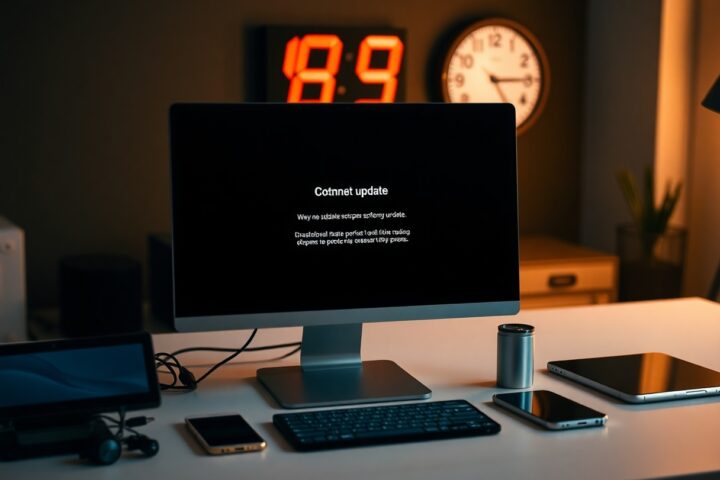It’s imperative for you to keep your software updated to ensure the security and efficiency of your devices. Regular updates not only patch vulnerabilities that could be exploited by cybercriminals but also improve functionality and introduce new features that enhance your user experience. By staying current with updates, you protect yourself from threats, optimize performance, and ensure compatibility with other software and hardware. Ignoring updates can lead to significant operational issues and security risks, so make it a priority to keep your software current for a smoother digital experience.
The Importance of Software Updates
To maintain a secure and efficient digital environment, it is vital for you to keep your software updated. Software updates not only enhance functionality but also address potential vulnerabilities that could compromise your system. Failing to update can lead to security breaches, data loss, and performance issues, making it imperative to prioritize updates as part of your routine digital hygiene.
Security Enhancements
An effective software update regularly includes vital security enhancements that protect your devices from newly discovered threats. As cyber threats evolve, developers continuously monitor and patch vulnerabilities to ensure your data remains safe. By updating your software, you reinforce your defenses against malware, ransomware, and other cyberattacks, ultimately safeguarding your personal information and maintaining your online safety.
Bug Fixes and Stability Improvements
Before you overlook the necessity of software updates, consider how often bugs and glitches can disrupt your user experience. These issues diminish functionality, slow performance, and can even lead to crashes, making tasks increasingly frustrating.
Software developers meticulously address bugs and inconsistencies in their applications, and each update aims to improve stability and performance. By regularly updating your software, you ensure that newly identified bugs are fixed, and user experience is optimized. This commitment to keeping your software current not only enhances performance but also allows you to fully leverage the latest features and improvements, ensuring a seamless interaction with your applications.
New Features and Functionality
While keeping your software updated, you unlock access to the latest features and enhancements designed to improve your experience. Often, software developers introduce new tools and functionalities that can streamline your workflow, boost productivity, and provide innovative solutions to your daily tasks. By regularly updating, you ensure you’re taking full advantage of these improvements, which can have a significant impact on your efficiency and overall performance.
User Experience Enhancements
User experience is greatly enhanced through software updates, as developers continually refine interfaces and interactions based on user feedback. These updates often feature more intuitive designs and improved navigation, making it easier for you to accomplish your goals with minimal barriers. An updated interface can enhance your comfort and satisfaction while using the software.
Compatibility with New Technologies
Above all, staying current with updates helps ensure that your software remains compatible with new technologies emerging in the market. As hardware and systems evolve, updates allow your software to function seamlessly with new solutions, avoiding potential disruptions and maintaining your productivity.
Even in fast-paced technological environments, software that isn’t updated may face challenges interfacing with new devices or applications. This compatibility ensures you can leverage the latest innovations without interruptions or functionality issues. Outdated software may also miss out on critical security patches that protect you from vulnerabilities introduced by new technologies. Keeping your software updated saves you time and maximizes the benefits from advancements in technology, ultimately allowing you to stay ahead in your personal and professional projects.
Prevention of Data Loss
The importance of keeping your software updated cannot be overstated when it comes to preventing data loss. Outdated software may harbor vulnerabilities that cybercriminals can exploit to gain unauthorized access to your systems and compromise your sensitive information. By regularly updating your software, you enhance its security features, protecting your valuable data from risks associated with unexpected breaches.
Backups and Recovery Solutions
Among the best practices in data protection is consistently backing up your files and using recovery solutions. Even if your software is up to date, having robust backups ensures that you can recover your information quickly in case of incidents like hardware failure or ransomware attacks. Automated backup solutions can eliminate the risk of human error and give you peace of mind that your data is secure.
Addressing Vulnerabilities
Below the surface of your software, vulnerabilities can lurk unnoticed, posing a constant threat to your data’s safety. Updating your software provides patches that fix flaws, minimizing the chances of exploitation. Without these updates, you leave your systems exposed to potential attacks that could lead to substantial data loss.
And, by staying proactive with your software updates, you not only address existing vulnerabilities but also stay ahead of emerging security challenges. The landscape of cybersecurity is ever-evolving, and threats can change rapidly. New vulnerabilities are discovered frequently, making timely updates crucial to fortify your systems. By keeping your software current, you create a robust defense against potential attacks, safeguarding your data and maintaining your integrity in a digital world.
Regulatory Compliance
Not keeping your software updated can expose you to significant compliance issues, especially in industries governed by strict regulations. Outdated software may not meet the latest security protocols or data protection laws, leaving your organization vulnerable to fines and other penalties. By staying current with updates, you align your operations with regulatory requirements, demonstrating your commitment to maintaining high standards and protecting sensitive information.
Meeting Industry Standards
Above all, regularly updating your software ensures that you maintain industry standards in technology and security. Many sectors, such as finance and healthcare, impose specific regulations regarding technology usage, and outdated systems may fail to meet these requirements. Keeping your software updated enables you to stay compliant with shifting regulations, which in turn enhances your reputation and operational integrity.
Avoiding Legal Issues
Compliance with software updates not only protects your data but also minimizes the risk of potential legal challenges against your organization.
Further, when you keep your software updated, you reduce vulnerabilities that could result in data breaches and security incidents. These situations can lead to litigation or irreversible reputational damage. By ensuring your software is always up to date, you actively demonstrate due diligence and a commitment to protecting customer information, keeping your business shielded from potentially damaging legal repercussions.
Cost Implications of Ignoring Updates
All software comes with a price, and neglecting updates can lead to unexpected expenses. Failing to update your software can expose you to vulnerabilities that may result in costly data breaches, efficiency losses, and even legal liabilities. When you overlook updates, you risk not only your immediate productivity but also the long-term health of your finances.
Potential Financial Risks
Any delay in updating could lead to potential financial risks. Cyberattacks resulting from outdated software can siphon off significant funds for repairs, legal fees, or even compensation claims. Additionally, downtime during such attacks can severely impact your ability to generate revenue, creating a trickle effect on your overall financial health.
Comparison of Long-term Investment
Investment in updates may seem like an expense, but it is fundamentally a long-term investment. Maintaining updated software not only helps you avoid potential pitfalls but also enhances the overall performance of your system, yielding cost efficiencies over time.
| Regular Updates | Minimized risk of data breaches and system failures |
| Neglecting Updates | Potential costs of recovery and lost productivity |
Another important aspect is how investing in updates can contribute to your long-term financial strategy. By proactively managing your software, you can not only avoid emergency expenses but also improve operational efficiency, which ultimately saves you money. Instead of viewing updates as mere costs, consider them a safeguard that protects your resources and enhances your bottom line.
| Enhanced Security | Protection against emerging cybersecurity threats |
| Improved Efficiency | Better software performance leading to increased productivity |
Best Practices for Keeping Software Updated
Despite the importance of software updates, many users often neglect them. To ensure your systems remain secure and efficient, establish a routine for checking and applying updates. This includes not only your operating system but also applications, antivirus software, and security tools. Staying proactive in updating software allows you to benefit from enhanced features and protects against vulnerabilities more effectively.
Setting Up Automatic Updates
Among the easiest ways to keep your software current is to enable automatic updates. Most modern software provides options to automatically download and install updates, minimizing the effort required on your part. By setting this feature up, you can ensure that updates occur regularly without manual intervention, reducing the risk of running outdated programs.
Regular Maintenance and Monitoring
Above all, consistent maintenance and monitoring of your software environment can significantly enhance performance and security. You should schedule periodic reviews to check for updates, assess the effectiveness of installed security measures, and identify any software that may require upgrades or replacements.
A good practice involves keeping an inventory of your software and the version numbers in use. This allows you to easily track which programs need updates. Additionally, regularly monitoring your software for any unusual activity or performance issues can help you detect potential problems early on. By staying engaged with your software maintenance, you can ensure your digital environment remains secure and functional, reducing the risk of incidents caused by outdated applications.
Conclusion
Summing up, keeping your software updated is imperative for ensuring the security and efficiency of your devices. By applying updates regularly, you protect yourself from vulnerabilities that can be exploited by malicious actors. Moreover, software updates often introduce new features and performance improvements that enhance your overall user experience. By prioritizing these updates, you empower your technology to perform at its best and safeguard your personal information. Don’t overlook the importance of staying current; it is a simple yet effective way to maintain your digital safety and satisfaction.




